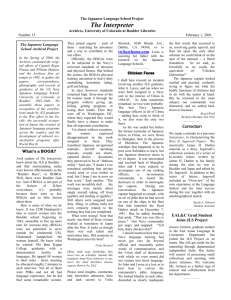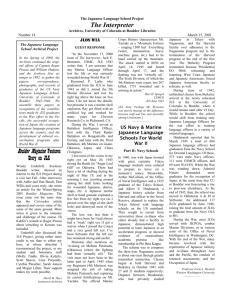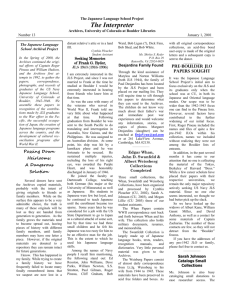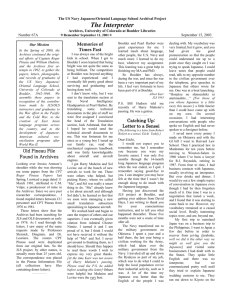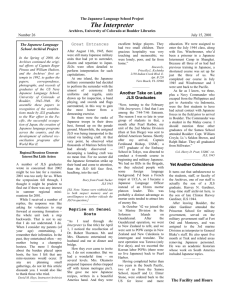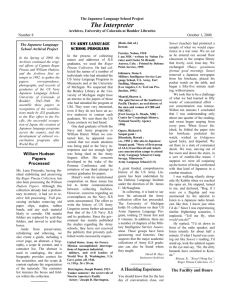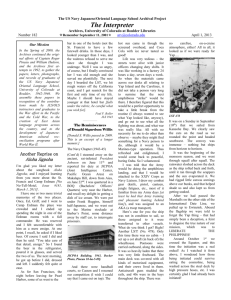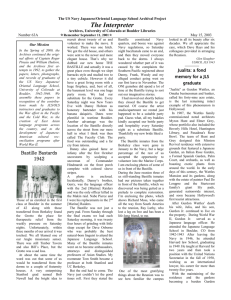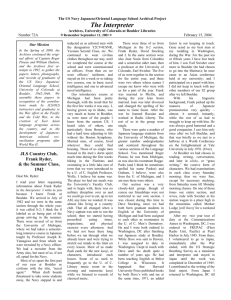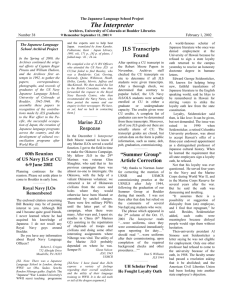The Japanese Language School Project
advertisement
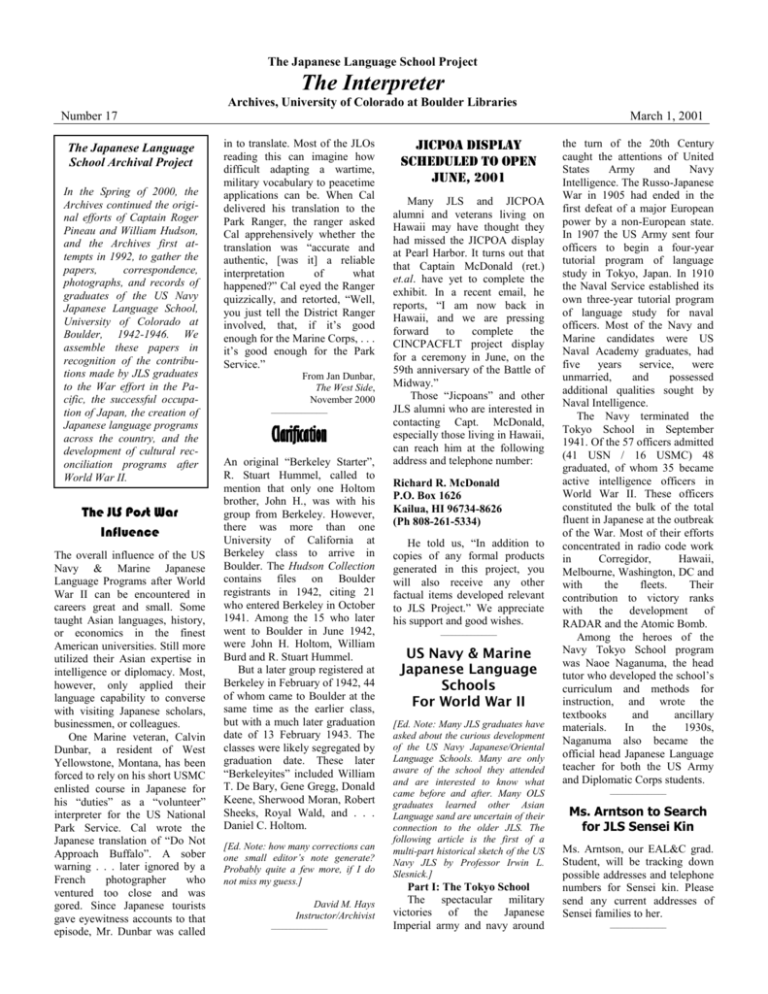
The Japanese Language School Project The Interpreter Archives, University of Colorado at Boulder Libraries Number 17 The Japanese Language School Archival Project In the Spring of 2000, the Archives continued the original efforts of Captain Roger Pineau and William Hudson, and the Archives first attempts in 1992, to gather the papers, correspondence, photographs, and records of graduates of the US Navy Japanese Language School, University of Colorado at Boulder, 1942-1946. We assemble these papers in recognition of the contributions made by JLS graduates to the War effort in the Pacific, the successful occupation of Japan, the creation of Japanese language programs across the country, and the development of cultural reconciliation programs after World War II. The JLS Post War Influence The overall influence of the US Navy & Marine Japanese Language Programs after World War II can be encountered in careers great and small. Some taught Asian languages, history, or economics in the finest American universities. Still more utilized their Asian expertise in intelligence or diplomacy. Most, however, only applied their language capability to converse with visiting Japanese scholars, businessmen, or colleagues. One Marine veteran, Calvin Dunbar, a resident of West Yellowstone, Montana, has been forced to rely on his short USMC enlisted course in Japanese for his “duties” as a “volunteer” interpreter for the US National Park Service. Cal wrote the Japanese translation of “Do Not Approach Buffalo”. A sober warning . . . later ignored by a French photographer who ventured too close and was gored. Since Japanese tourists gave eyewitness accounts to that episode, Mr. Dunbar was called March 1, 2001 in to translate. Most of the JLOs reading this can imagine how difficult adapting a wartime, military vocabulary to peacetime applications can be. When Cal delivered his translation to the Park Ranger, the ranger asked Cal apprehensively whether the translation was “accurate and authentic, [was it] a reliable interpretation of what happened?” Cal eyed the Ranger quizzically, and retorted, “Well, you just tell the District Ranger involved, that, if it’s good enough for the Marine Corps, . . . it’s good enough for the Park Service.” From Jan Dunbar, The West Side, November 2000 _______________ Clarification An original “Berkeley Starter”, R. Stuart Hummel, called to mention that only one Holtom brother, John H., was with his group from Berkeley. However, there was more than one University of California at Berkeley class to arrive in Boulder. The Hudson Collection contains files on Boulder registrants in 1942, citing 21 who entered Berkeley in October 1941. Among the 15 who later went to Boulder in June 1942, were John H. Holtom, William Burd and R. Stuart Hummel. But a later group registered at Berkeley in February of 1942, 44 of whom came to Boulder at the same time as the earlier class, but with a much later graduation date of 13 February 1943. The classes were likely segregated by graduation date. These later “Berkeleyites” included William T. De Bary, Gene Gregg, Donald Keene, Sherwood Moran, Robert Sheeks, Royal Wald, and . . . Daniel C. Holtom. [Ed. Note: how many corrections can one small editor’s note generate? Probably quite a few more, if I do not miss my guess.] David M. Hays Instructor/Archivist _______________ JicPoa Display Scheduled to Open June, 2001 Many JLS and JICPOA alumni and veterans living on Hawaii may have thought they had missed the JICPOA display at Pearl Harbor. It turns out that that Captain McDonald (ret.) et.al. have yet to complete the exhibit. In a recent email, he reports, “I am now back in Hawaii, and we are pressing forward to complete the CINCPACFLT project display for a ceremony in June, on the 59th anniversary of the Battle of Midway.” Those “Jicpoans” and other JLS alumni who are interested in contacting Capt. McDonald, especially those living in Hawaii, can reach him at the following address and telephone number: Richard R. McDonald P.O. Box 1626 Kailua, HI 96734-8626 (Ph 808-261-5334) He told us, “In addition to copies of any formal products generated in this project, you will also receive any other factual items developed relevant to JLS Project.” We appreciate his support and good wishes. _______________ US Navy & Marine Japanese Language Schools For World War II [Ed. Note: Many JLS graduates have asked about the curious development of the US Navy Japanese/Oriental Language Schools. Many are only aware of the school they attended and are interested to know what came before and after. Many OLS graduates learned other Asian Language sand are uncertain of their connection to the older JLS. The following article is the first of a multi-part historical sketch of the US Navy JLS by Professor Irwin L. Slesnick.] Part I: The Tokyo School The spectacular military victories of the Japanese Imperial army and navy around the turn of the 20th Century caught the attentions of United States Army and Navy Intelligence. The Russo-Japanese War in 1905 had ended in the first defeat of a major European power by a non-European state. In 1907 the US Army sent four officers to begin a four-year tutorial program of language study in Tokyo, Japan. In 1910 the Naval Service established its own three-year tutorial program of language study for naval officers. Most of the Navy and Marine candidates were US Naval Academy graduates, had five years service, were unmarried, and possessed additional qualities sought by Naval Intelligence. The Navy terminated the Tokyo School in September 1941. Of the 57 officers admitted (41 USN / 16 USMC) 48 graduated, of whom 35 became active intelligence officers in World War II. These officers constituted the bulk of the total fluent in Japanese at the outbreak of the War. Most of their efforts concentrated in radio code work in Corregidor, Hawaii, Melbourne, Washington, DC and with the fleets. Their contribution to victory ranks with the development of RADAR and the Atomic Bomb. Among the heroes of the Navy Tokyo School program was Naoe Naganuma, the head tutor who developed the school’s curriculum and methods for instruction, and wrote the textbooks and ancillary materials. In the 1930s, Naganuma also became the official head Japanese Language teacher for both the US Army and Diplomatic Corps students. _______________ Ms. Arntson to Search for JLS Sensei Kin Ms. Arntson, our EAL&C grad. Student, will be tracking down possible addresses and telephone numbers for Sensei kin. Please send any current addresses of Sensei families to her. _______________ The Facility and Hours To Donate Archives is located in the basement of Norlin Library at the east end of the historic quadrangle on the Boulder campus of the University of Colorado. If you wish to donate your materials, please contact the Archives to insure the proper mailing address. For large shipments, the archives will reimburse expenses. Upon receipt of materials we will send the donator a deed of gift with instructions. The donator must return to the Archives signed deeds of gift. The Archives will then provide copies of preliminary inventories and guides to donors and donor families when available. Feel free to contact us at any time. The Archives is open MWF, 1100-1700, but is staffed from 0800-1700, M-F. Out of town researchers may arrange for early and every day entry. Photocopying and both photographic and audiovisual reproduction services are available. New Collections Contact Bruce Montgomery, Curator, or David Hays, Archivist, Archives, The following are further collections promised, held or recently received by the Archives: University of Colorado at Boulder Campus Box 184 Boulder, Colorado, 80309-0184 Phone (303) 492-7242 Fax (303) 492-3960 Email: montgomb@spot.colorado.edu arv@colorado.edu Website: www-libraries.colorado.edu/ps/arv/ frontpage.htm F. Hilary Conroy Arthur Dornheim Robert F. Durden Edward L. Hart David (Nancy) Hornstein Frank Ryder Hart H. Spiegel Lawrence C. Vincent
